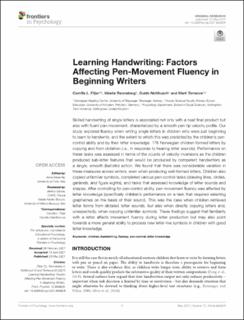| dc.contributor.author | Fitjar, Camilla Lausund | |
| dc.contributor.author | Rønneberg, Vibeke | |
| dc.contributor.author | Nottbusch, Guido | |
| dc.contributor.author | Torrance, Mark | |
| dc.date.accessioned | 2021-06-01T08:18:41Z | |
| dc.date.available | 2021-06-01T08:18:41Z | |
| dc.date.created | 2021-05-20T16:19:24Z | |
| dc.date.issued | 2021-05 | |
| dc.identifier.citation | Fitjar, C.L., Rønneberg, V., Nottbusch, G., Torrance, M. (2021) Learning Handwriting: Factors Affecting Pen-Movement Fluency in Beginning Writers. Frontiers in Psychology, | en_US |
| dc.identifier.issn | 1664-1078 | |
| dc.identifier.uri | https://hdl.handle.net/11250/2757152 | |
| dc.description.abstract | Skilled handwriting of single letters is associated not only with a neat final product but also with fluent pen-movement, characterized by a smooth pen-tip velocity profile. Our study explored fluency when writing single letters in children who were just beginning to learn to handwrite, and the extent to which this was predicted by the children’s pen-control ability and by their letter knowledge. 176 Norwegian children formed letters by copying and from dictation (i.e., in response to hearing letter sounds). Performance on these tasks was assessed in terms of the counts of velocity inversions as the children produced sub-letter features that would be produced by competent handwriters as a single, smooth (ballistic) action. We found that there was considerable variation in these measures across writers, even when producing well-formed letters. Children also copied unfamiliar symbols, completed various pen-control tasks (drawing lines, circles, garlands, and figure eights), and tasks that assessed knowledge of letter sounds and shapes. After controlling for pen-control ability, pen-movement fluency was affected by letter knowledge (specifically children’s performance on a task that required selecting graphemes on the basis of their sound). This was the case when children retrieved letter forms from dictated letter sounds, but also when directly copying letters and, unexpectedly, when copying unfamiliar symbols. These findings suggest that familiarity with a letter affects movement fluency during letter production but may also point towards a more general ability to process new letter-like symbols in children with good letter knowledge. | en_US |
| dc.language.iso | eng | en_US |
| dc.publisher | Frontiers Media S.A | en_US |
| dc.rights | Navngivelse 4.0 Internasjonal | * |
| dc.rights.uri | http://creativecommons.org/licenses/by/4.0/deed.no | * |
| dc.subject | håndskrift | en_US |
| dc.title | Learning Handwriting: Factors Affecting Pen-Movement Fluency in Beginning Writers | en_US |
| dc.type | Peer reviewed | en_US |
| dc.type | Journal article | en_US |
| dc.description.version | publishedVersion | en_US |
| dc.rights.holder | © 2021 Fitjar, Rønneberg, Nottbusch and Torrance. | en_US |
| dc.subject.nsi | VDP::Humaniora: 000 | en_US |
| dc.subject.nsi | VDP::Samfunnsvitenskap: 200::Psykologi: 260 | en_US |
| dc.source.journal | Frontiers in Psychology | en_US |
| dc.identifier.doi | 10.3389/fpsyg.2021.663829 | |
| dc.identifier.cristin | 1911134 | |
| cristin.ispublished | true | |
| cristin.fulltext | original | |
| cristin.qualitycode | 2 | |

